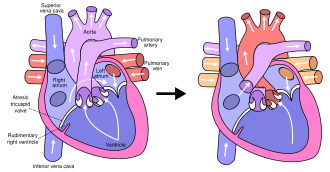Pulmonary atresia

Editor-In-Chief: Prab R Tumpati, MD
Obesity, Sleep & Internal medicine
Founder, WikiMD Wellnesspedia &
W8MD medical weight loss NYC and sleep center NYC
| Pulmonary atresia | |
|---|---|

| |
| Synonyms | |
| Pronounce | N/A |
| Specialty | N/A |
| Symptoms | Cyanosis, shortness of breath, fatigue, poor feeding |
| Complications | Heart failure, arrhythmia, growth retardation |
| Onset | Neonatal |
| Duration | Lifelong |
| Types | Pulmonary atresia with intact ventricular septum, Pulmonary atresia with ventricular septal defect |
| Causes | Congenital heart defect |
| Risks | Family history, genetic disorders |
| Diagnosis | Echocardiogram, cardiac catheterization, chest X-ray |
| Differential diagnosis | Tetralogy of Fallot, tricuspid atresia, transposition of the great arteries |
| Prevention | None |
| Treatment | Surgery, medication, cardiac catheterization |
| Medication | Prostaglandin E1 |
| Prognosis | Variable, depends on severity and treatment |
| Frequency | Rare |
| Deaths | |


Pulmonary atresia is a form of heart disease that occurs from birth (congenital heart disease). It is characterized by the absence or underdevelopment of the pulmonary valve, which regulates blood flow from the right ventricle (lower chamber) of the heart to the pulmonary artery. This condition can lead to a lack of blood flow to the lungs, preventing the normal oxygenation of blood.
Symptoms[edit]
The symptoms of pulmonary atresia may vary depending on the specific type of the condition. Common symptoms include cyanosis (a bluish coloration of the skin due to lack of oxygen), shortness of breath, fatigue, and rapid breathing. In severe cases, the condition can lead to heart failure.
Causes[edit]
The exact cause of pulmonary atresia is unknown. However, it is believed to occur during the first 8 weeks of fetal development. Some factors that may increase the risk of developing this condition include maternal use of certain medications during pregnancy, maternal alcohol use, and a family history of congenital heart disease.
Diagnosis[edit]
Pulmonary atresia is usually diagnosed shortly after birth through a physical examination and the use of imaging tests such as an echocardiogram, cardiac catheterization, and magnetic resonance imaging (MRI).
Treatment[edit]
The treatment for pulmonary atresia depends on the severity of the condition and the presence of other heart defects. Treatment options may include medications, catheter procedures, and surgery. In some cases, a heart transplant may be necessary.
Prognosis[edit]
The prognosis for individuals with pulmonary atresia varies. With early diagnosis and treatment, many individuals can lead a normal life. However, ongoing medical care is often necessary.
See also[edit]
References[edit]
<references />
Ad. Transform your life with W8MD's Budget GLP-1 injections from $75


W8MD offers a medical weight loss program to lose weight in Philadelphia. Our physician-supervised medical weight loss provides:
- Weight loss injections in NYC (generic and brand names):
- Zepbound / Mounjaro, Wegovy / Ozempic, Saxenda
- Most insurances accepted or discounted self-pay rates. We will obtain insurance prior authorizations if needed.
- Generic GLP1 weight loss injections from $75 for the starting dose.
- Also offer prescription weight loss medications including Phentermine, Qsymia, Diethylpropion, Contrave etc.
NYC weight loss doctor appointmentsNYC weight loss doctor appointments
Start your NYC weight loss journey today at our NYC medical weight loss and Philadelphia medical weight loss clinics.
- Call 718-946-5500 to lose weight in NYC or for medical weight loss in Philadelphia 215-676-2334.
- Tags:NYC medical weight loss, Philadelphia lose weight Zepbound NYC, Budget GLP1 weight loss injections, Wegovy Philadelphia, Wegovy NYC, Philadelphia medical weight loss, Brookly weight loss and Wegovy NYC
|
WikiMD's Wellness Encyclopedia |
| Let Food Be Thy Medicine Medicine Thy Food - Hippocrates |
Medical Disclaimer: WikiMD is not a substitute for professional medical advice. The information on WikiMD is provided as an information resource only, may be incorrect, outdated or misleading, and is not to be used or relied on for any diagnostic or treatment purposes. Please consult your health care provider before making any healthcare decisions or for guidance about a specific medical condition. WikiMD expressly disclaims responsibility, and shall have no liability, for any damages, loss, injury, or liability whatsoever suffered as a result of your reliance on the information contained in this site. By visiting this site you agree to the foregoing terms and conditions, which may from time to time be changed or supplemented by WikiMD. If you do not agree to the foregoing terms and conditions, you should not enter or use this site. See full disclaimer.
Credits:Most images are courtesy of Wikimedia commons, and templates, categories Wikipedia, licensed under CC BY SA or similar.
Translate this page: - East Asian
中文,
日本,
한국어,
South Asian
हिन्दी,
தமிழ்,
తెలుగు,
Urdu,
ಕನ್ನಡ,
Southeast Asian
Indonesian,
Vietnamese,
Thai,
မြန်မာဘာသာ,
বাংলা
European
español,
Deutsch,
français,
Greek,
português do Brasil,
polski,
română,
русский,
Nederlands,
norsk,
svenska,
suomi,
Italian
Middle Eastern & African
عربى,
Turkish,
Persian,
Hebrew,
Afrikaans,
isiZulu,
Kiswahili,
Other
Bulgarian,
Hungarian,
Czech,
Swedish,
മലയാളം,
मराठी,
ਪੰਜਾਬੀ,
ગુજરાતી,
Portuguese,
Ukrainian




